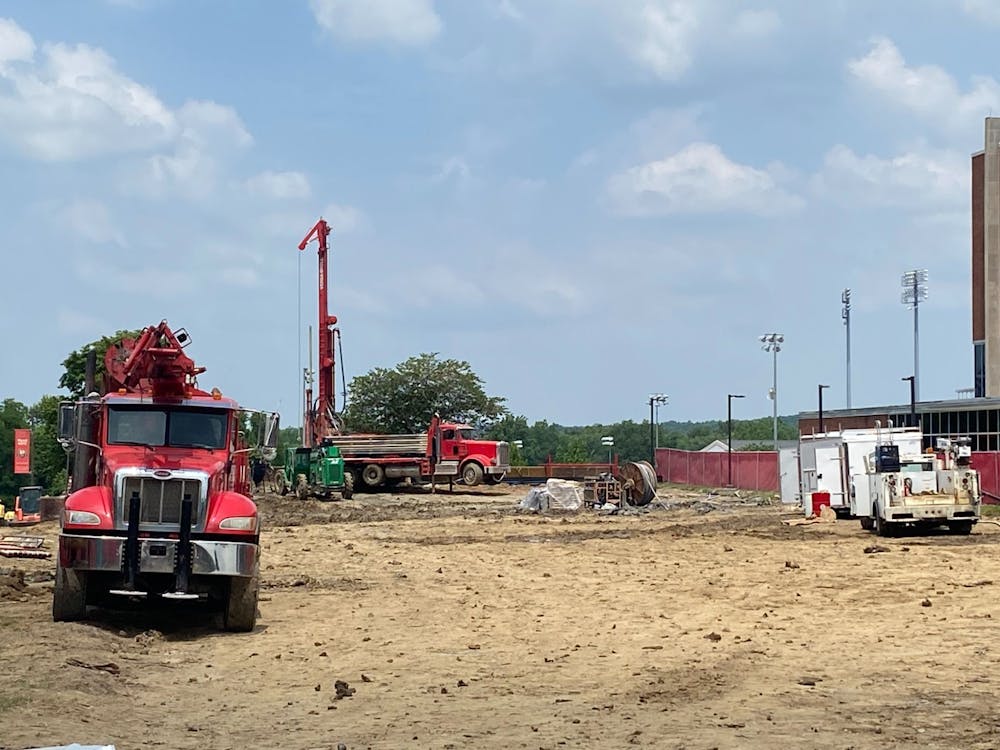Upon returning to campus this fall, students will see new construction outside Miami University’s Millett Hall. The flat dirt field lined with red fences south of the stadium will become home to 520 underground geothermal wells, reaching 850 feet in depth.
The project is an effort to transition north campus buildings – including Millett Hall – off steam energy towards heating and cooling through geothermal exchange. This comes as part of Miami’s climate action plan’s goal of reaching carbon neutrality by 2040 on the Oxford campus.
Miami’s Director of Sustainability Olivia Herron describes geothermal exchange as using the Earth as a battery to store heat. In the summer, air conditioning removes heat from the buildings and uses that energy to warm up the ground. In the winter, the heat stored in the ground will be used to warm up the buildings.
Herron said the project is expected to reduce carbon emissions by 5,810 metric tons annually – the equivalent of more than 360 individual human emissions yearly. The project is being carried out under Miami’s physical facilities department and led by Project Director Don Van Winkle
“It’s a big project towards President [Gregory Crawford]’s goal of getting towards climate [neutrality],” Van Winkle said. “It’s going to allow us to be much less dependent on fossil fuels.”
Herron said the project has two main phases. The first is drilling geothermal wells and connecting these wells to buildings, and the second is putting equipment in buildings that will allow them to accept water from the wellfield.
Once both phases are complete – which, according to Van Winkle, will take at least through the summer of 2026 – the university can begin utilizing geothermal exchange.
In the meantime, Herron said they are trying to minimize the impact on students.
One step of the project requires digging a trench and laying down pipe across the intersection of Tallawanda, Sycamore and Bonham road, which meet outside of Millett Hall. This will connect the North chiller plant – which provides air conditioning to the North side of campus – to the wellfield.
To avoid sidewalk closures and noisy construction near residence halls during the school year, this step of the project will be completed by the end of the summer.
“We have tried to be intentional, like doing this trenching over the summer so that it’s completely done before students are back,” Herron said.
Drilling will continue throughout the school year. According to Herron, noise levels are minimal in comparison to other construction processes, and all construction will take place during business hours.
Enjoy what you're reading?
Signup for our newsletter
Although the grassy area outside of Millett will be closed for the duration of the project, Van Winkle said the building will be used as normal throughout its transition from steam to geothermal.
Around the summer of 2026, there may be times when the building does not have full ventilation capabilities, Van Winkle said. However, this would not be during any large events that would require such ventilation.
“We shouldn’t be doing anything that’s going to be closing down the building so that it cannot be used as planned,” Van Winkle said.
Herron said that when the project is done, the hope is that students will have more efficient and accurate climate control in buildings. According to Van Winkle, the geothermal exchange system will lessen the amount of fossil fuel released by allowing buildings on North campus to remain off of steam-generated heat at much lower temperatures.
According to Herron and Van Winkle, the diversity of the geology within the wellfield makes completing drilling a challenge. In the early stages the equipment requires fine-tuning and the location requires troubleshooting.
“It has started out pretty slow,” Van Winkle said. “We’re hoping that it continues to speed up as we fine-tune the equipment for the location where they’re drilling.”
The ground being drilled is an old landfill, and they’ve been keeping an eye on some concerns specific to that location. One concern involves potential delays caused by encountering any large pockets of methane; however, they have not experienced much of this so far.
While the summer’s main focus for the university’s carbon neutrality pledge has been starting up geothermal drilling, Herron says other initiatives are already underway. The Bachelor Hall renovations are another step, as they will allow the hall to be serviced by the already existing Western geothermal plant.
A solar energy project over the existing Western campus geothermal wellfield behind Hillcrest Hall is expected to begin in February 2025. Herron looks towards the newest geothermal project and these next steps with optimism.
“It’s been a long time in the making, so it’s very exciting to see it come to fruition,” she said.
kennelse@miamioh.edu




